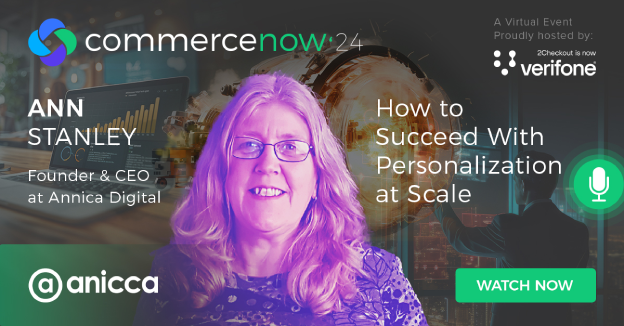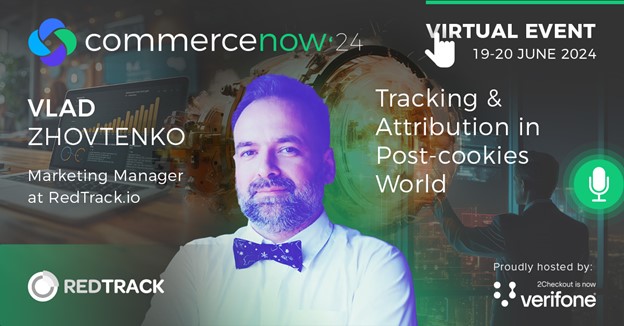CommerceNow 2024 gathered industry experts and innovators to share forward-thinking strategies shaping the future of digital commerce. This year’s event offered fresh insights into topics like AI’s growing influence and the role of data analytics in enhancing customer experiences.
Whether you’re a marketer, an eCommerce merchant, or simply aiming to stay ahead in the digital space, these sessions offer actionable strategies to optimize performance and drive conversions.
In this wrap-up, we’ll explore top insights from four expert-led sessions featuring Pierre DeBois, Ann Stanley, Vlad Zhovtenko, and Luke O’Leary. Key highlights include:
- Data strategies to enhance customer experiences and retention,
- The transformative impact of AI and social search on search engines,
- Navigating tracking and attribution in a post-cookies world, and
- Leveraging AI to maximize eCommerce conversions.
Let’s dive into the standout moments and key takeaways from each talk.
How to Harness Data for Powerful Customer Retention
Pierre DeBois explains that customer retention is more than just satisfying customers—it’s about using data to understand and anticipate their needs. Many companies focus heavily on acquiring new customers, but Pierre emphasizes the importance of nurturing relationships with existing ones.
By leveraging data, businesses can not only retain their customers but also build long-term relationships that drive growth.
Going Beyond Basic Metrics
One of the tools Pierre recommends is Google Analytics, which allows businesses to dig deeper into customer behavior. By looking at metrics like churn rates and customer lifetime value (CLV), businesses can spot when customers are at risk of leaving and take steps to keep them engaged.
Pierre stresses that this isn’t just about numbers—it’s about using the data to tell a story and make smarter, more personalized decisions.
Cohort Analysis for Targeted Engagement
A powerful strategy Pierre highlights is cohort analysis, which groups customers based on shared behaviors over time. This method helps businesses see patterns and understand which groups are disengaging. Armed with this insight, companies can step in with tailored offers, relevant content, or better service to re-engage at-risk customers.
Pierre’s message is clear: Data is more than a tool for tracking—it’s a way to create meaningful connections with your customers. By interpreting customer behavior and acting on it, businesses can turn data into a powerful asset for driving retention and profitability.
But data insights alone aren’t enough to drive sustainable growth.
This is where AI becomes transformative, using data not just to maintain relationships, but to elevate them by driving conversions.
Make sure to watch Pierre’s full session for a better overview on how to leverage analytics in your customer retention strategies.
Speed First: The Key to AI-Driven Conversion Success
Luke O’Leary explains that page load speed—a basic but crucial element—can make or break a sale. He highlights examples from major brands like Walmart and Amazon, who have fine-tuned their page speeds to directly boost sales.
For instance, Walmart found that even a one-second delay in loading time led to a 2% drop in conversions. This example might seem like a small technical detail, but it reveals a bigger picture: even the most advanced AI strategies won’t matter if users are frustrated by a slow website.
That’s where AI becomes relevant. Luke stresses that AI can only perform as well as the foundation it’s built on. No matter how sophisticated your AI-driven personalization or optimization strategies are, they won’t save a poor user experience caused by slow page loads.
In other words, fast websites create the right environment for AI to thrive. Once page speed and other foundational elements are optimized, AI can then step in to amplify results.
For example, AI can personalize product recommendations, adjust pricing based on real-time data, or offer timely promotions. As Luke points out, it’s the combination of strong technical performance and smart AI strategies that leads to higher conversions.
Leveraging AI to Elevate the Customer Journey
According to Luke, AI’s most notable strength lies in its power to personalize every aspect of the customer journey.
Luke explains that AI does more than just optimize processes—it helps businesses respond to customer behavior in real-time, delivering experiences that feel tailored and relevant. Personalization is no longer optional; it’s essential for companies looking to improve customer retention and overall satisfaction.
Augmented Reality in eCommerce
One standout example Luke shares is how brands like IKEA use augmented reality (AR) to create a more personalized shopping experience. With AR, IKEA customers can visualize furniture and products in their own homes, allowing them to make more informed decisions without stepping into a physical store.
This AI-powered tool not only makes the shopping journey more interactive but also reduces hesitation, guiding customers from discovery to purchase more seamlessly.
Building Trust and Loyalty with Personalization
But AI-driven personalization goes beyond just technology like AR. Luke stresses that authenticity is key. Today’s customers expect their experiences to be tailored to their preferences, and businesses that meet these expectations can see significant results—up to 40% more revenue.
AI allows companies to anticipate customer needs based on patterns of interaction, making sure the right products, offers, or recommendations appear at just the right moment.
Whether it’s a well-timed discount on an abandoned cart or personalized product suggestions based on browsing history, AI helps businesses ensure that their most persuasive elements are always in play at the most impactful moments.
This level of insight also extends to pricing strategies, where AI can analyze market trends, competitor pricing, and customer preferences to help businesses determine the optimal price point for their products.
It’s no longer just about lowering prices to make a sale; it’s about understanding what drives customer decisions and leveraging that information to maximize both customer satisfaction and profitability.
This deep level of personalization builds trust, engagement, and long-term loyalty.
Luke’s insights make it clear: AI isn’t just a tool for efficiency; it’s a critical asset for creating personalized, meaningful customer experiences. By integrating AI at every stage of the customer journey, businesses can elevate the way they interact with customers, fostering deeper relationships and stronger loyalty.
Get access to more of Luke’s insights by watching his entire CommerceNow 2024 session.
The Rise of Social Search: Adapting to New Search Behaviors
The Shift from Traditional to Social Search
While AI helps businesses refine personalization and customer interactions, the way customers discover products is also evolving, forcing businesses to rethink their approach to search behavior.
Ann Stanley explains that platforms like TikTok, Instagram, and YouTube have evolved from social networks into powerful search engines, especially for younger generations. Gen Z users, in particular, are turning to these platforms for product recommendations, trend research, and even direct purchases.
This shift means that traditional SEO strategies focused solely on Google are no longer enough.
Optimizing for Social Search Platforms
Ann specifically highlights TikTok as a growing force in the world of search. With TikTok Shop, users can now buy products directly through the app, and its 5% commission makes it a strong competitor to platforms like Amazon.
Ann emphasizes that businesses must optimize for these social search engines to stay relevant, ensuring their content is visible where customers are actively engaging.
To stay competitive, Ann suggests that businesses integrate social search into their broader marketing strategies. This includes creating content that resonates with audiences on platforms like TikTok and Instagram and understanding how each platform’s algorithm surfaces content.
By embracing this new search landscape, businesses can tap into more opportunities for visibility and engagement.
Adapting to Generative Search Optimization (GSO)
Another crucial point Ann highlights is how generative AI tools like ChatGPT-4 and Google’s AI Overviews are changing the way search results appear. These technologies now offer direct, conversational answers to users’ questions, meaning fewer people are clicking through to traditional websites.
To stay visible, Ann emphasizes that businesses need to adapt their SEO strategies to focus on Generative Search Optimization (GSO). This means creating content that AI tools recognize as valuable and trustworthy.
Ann suggests businesses should aim to get their content featured in sources that AI pulls from, like well-established platforms and databases, to ensure they are part of these AI-generated answers.
And while adapting to AI-driven search is crucial for visibility, businesses must also rethink how they track and measure customer behavior as privacy regulations tighten and traditional methods become less effective.
Don’t miss out on Ann Stanley’s full session to learn how social search and generative AI will change search engines forever.
Mastering Tracking and Attribution in a Post-Cookies World
The Shift to First-Party Data
As third-party cookies fade out, businesses are grappling with how to maintain accurate tracking and attribution. Vlad Zhovtenko stresses that transitioning to first-party data isn’t just a workaround—it’s now essential for any business wanting to stay competitive.
With growing privacy regulations like GDPR and CCPA, companies need to adopt new methods of gathering customer data while ensuring they remain compliant with these stricter standards.
Vlad stresses the importance of businesses building their own systems to collect first-party data. With third-party cookies disappearing, companies need to rely on data they gather directly from customers through interactions on their own websites, apps, or services.
An additional example Vlad offers is how independent data collection and first-party data ownership provide more flexibility. By collecting data from across channels—whether it’s from ad networks or directly from websites—businesses can combine this data to create more accurate attribution models.
This leads to better decision-making and ensures that marketing dollars are being spent effectively.
By building their own data collection tools and systems, companies can gain a deeper understanding of how their customers behave across different channels. This not only helps improve marketing efforts but also ensures that businesses remain compliant with ever-evolving privacy laws.
Conversion APIs for Precise Ad Targeting
Vlad also explains that one of the most effective strategies in this post-cookies world is the use of conversion APIs. These APIs allow businesses to send hashed customer data, such as email addresses or phone numbers, directly back to ad networks like Facebook, TikTok, and Google.
By doing so, companies can still deliver precise ad targeting even without relying on third-party cookies. According to Vlad, conversion APIs are often overlooked, but they are key to maintaining efficient and effective marketing spend.
They ensure that businesses can continue reaching the right audiences with the right messages, even as data privacy regulations tighten.
Attribution Challenges and Solutions
Another important point Vlad highlights is the challenge of properly attributing marketing costs and revenue across different channels. He explains that without a clear breakdown of performance data, businesses can struggle to understand which channels are driving the best results.
As he puts it, companies that include granular data on costs, conversions, and revenue for each channel can better evaluate the effectiveness of their marketing campaigns.
This allows them to make more informed decisions, improving the allocation of their marketing budgets and maximizing ROI.
By embracing tools like conversion APIs and focusing on first-party data, businesses can continue to track customer interactions effectively while respecting privacy regulations.
Automation in Modern Tracking
Moreover, Vlad explains the value of automation in modern tracking. AI-driven systems and automation tools can alert businesses when performance metrics drop below expected levels or when certain campaigns outperform others, allowing for immediate adjustments.
This ensures that ad spend is optimized and wasted budget is minimized. For companies with limited resources, Vlad encourages leveraging such automation to maintain performance without the constant need for manual oversight.
To watch Vlad’s full talk, make sure to visit the dedicated session page.
Wrapping Up: Driving Success with Data, AI, and Customer-Centric Strategies
Succeeding in eCommerce today goes beyond just following trends—it’s about mastering every aspect of digital commerce, from understanding customer data to optimizing marketing strategies and embracing new technologies like generative AI.
Businesses that thrive are those that can seamlessly blend personalization, data-driven insights, and innovative solutions to meet evolving customer expectations.
To dive deeper into these cutting-edge strategies, watch the full CommerceNow’24 sessions. Hear from industry leaders like Pierre, Ann, Vlad, Luke, and other speakers, and gain actionable insights to take your eCommerce business to the next level.










